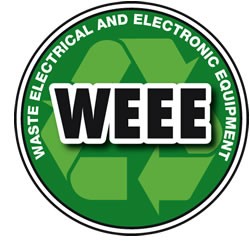European Commission: Third-Party Cartridge Manufacturers Must Also Comply with WEEE Directive

Fewer printer cartridges are expected to end up in landfills and more will be properly recycled or reused following the European Commission’s confirmation that remanufacturers of printer cartridges must also fulfill their environmental and financial obligations like any other manufacturer, whether it’s an OEM (original equipment manufacturer) or a third-party producer.
Responding to a question from EuroVAprint, the European Commission clarified that remanufacturers, refillers, and any other third-party cartridge producer should also comply with European law and more specifically with the existing Waste Electrical and Electronic Equipment (WEEE) Directive.
When buying printer cartridges, customers are being urged to look for the WEEE logo.
The WEEE Directive (applied in all 28 European Union [EU] member states) is said to impose “several obligations on producers of electrical and electronic equipment with regards to collection and proper treatment of waste, aiming to reduce the impact of e-waste on the environment,” according to EuroVAprint, a non-profit association for printer, copier/MFP, and consumables makers that’s dedicated to reducing waste and achieving energy efficiency.
According to EuroVAprint, complying with the WEEE Directive means that not only OEMs, but also remanufacturers need to register, report, and finance the take-back of waste from the products they sell. It recommends that European consumers and public buyers should look for and check that the printer cartridges they buy – remanufactured or not – carry the WEEE logo on the packaging, instructions for use, warranty and/ or on the cartridge.
Sara Rodriguez Martinez, president of EuroVAprint, commented: “Printer and copier manufacturers have been delivering consistently impressive energy-efficiency results with positive environmental impact during recent years. We are very pleased that the commission supports this effort by confirming that manufacturers of not only new, but also any third party-cartridges placed on the EU market under their own trademark need to follow the same rules. Enforcement is crucial if we want to see further positive results.”
EuroVAprint says it serves as a platform to ensure the implementation and monitoring of a voluntary agreement for imaging equipment concluded in 2011, and sanctioned by the commission as an implementing measure under the Ecodesign Directive. It seeks to reduce the environmental footprint of imaging equipment for home and office-use copiers, printers, fax machines, and MFPs. It says it’s delivered impressive energy-efficiency results for five years in a row, as those manufacturers agreeing to the pledge have achieved energy consumption cuts of 46.2 percent from 2011 to 2016 for inkjet products.
The WEEE Directive (applied in all 28 EU Member States) imposes several obligations on producers of electrical and electronic equipment with regards to collection and proper treatment of waste, aiming to reduce the impact of e-waste on the environment. Complying with the WEEE Directive means that not only OEM but also remanufacturers need to register, report, and finance the take-back of waste from the products they sell. European consumers and public buyers should look for and check that the printer cartridges they buy – remanufactured or not – carry the WEEE logo on the packaging, instructions for use, warranty and/ or on the cartridge.
“Printer and copier manufacturers have been delivering consistently impressive energy efficiency results with positive environmental impact during recent years. We are very pleased that the Commission supports this effort by confirming that manufacturers of not only new but also any third party-cartridges placed on the EU market under their own trademark need to follow the same rules. Enforcement is crucial if we want to see further positive results,” said Sara Rodriguez Martinez, President of EuroVAprint.

You must be logged in to post a comment.